-

新人教版高中英语必修3Unit 5 The Value of Money- Discovering Useful Structure教学设计
Step 3 Meaning1. 过去将来时表示从过去某一时间来看将要发生的动作或存在的状态, 常用在宾语从句中。一般由“would/should +动词原形”构成。She hoped that they would meet again someday. 她希望将来有一天他们能再见面。2. was/were going to+动词原形: 表示过去将要发生或很有可能发生的动作, 常用于口语中, 表示预言、意图或者打算等。He was going to start work the following week. 他打算下星期开始工作。3. was/were about to do: 常用来表示即将发生的动作, “刚要/正要做……”。注意该结构不与任何时间状语连用。I felt that something terrible was about to happen. 我感到某种可怕的事情即将发生。4.was/were to do: 表示“曾计划做某事”, 如果表示“本来计划做某事, 动作没实现”, 则需用 “was/were to have done”。She said she was to have told me about the accident. 她说她本来想告诉我关于事故的事。5.Start, go, come, leave, see, meet等动词的过去进行时: 表示就过去某一时刻而言即将发生的动作。She was coming later. 她随后就来。I had just put on my overcoat and was leaving to visit a friend of mine. 我刚穿上外套要去看我的一个朋友。
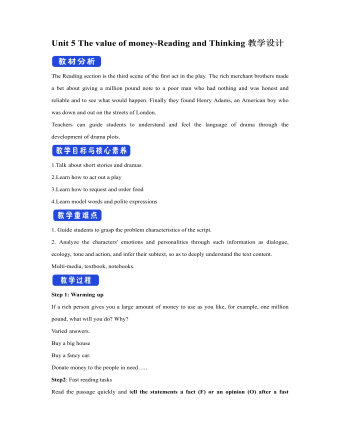
新人教版高中英语必修3Unit 5 The value of money-Reading and Thinking教学设计二
? Could you offer me some kind of work here?? I don’t want your charity, I just want an honest job.? Careless: I landed in Britain by accident.Step 7:Consolidation.? Find Henry? Roderick and Oliver were I .making a bet when they saw Henry, a poor young man. ? Know Henry? About a month ago, Henry was sailing and later he found himself carried out to sea by a strong wind. Fortunately, he 2.was spotted by a ship. And it was the ship that brought him to 3.England? Offer money to Henry ? Oliver and Roderick gave Henry a letter and told him that there was money in it. They 4.persuaded him to accept it, and made him 5.promise that it wouldn't be opened until 2 o'clock.Step 8:Language pointsa large amount of: a large quantity of; a great deal ofe.g. They bought a large amount of furniture before they moved their new house.make a bet: make an arrangement to risk money, etc. on an event of which the result is doubtful.e.g. We made a bet on the result of the match.permit sb to do something: allow somebody to do somethinge.g. My mother doesn’t permit me to ride in the street after it rained.by accident: as a result of chancee.g. I only found it by accident.stare at: look at somebody or something with the eyes wide open in a fixed gaze( in astonishment, wonder, fear, etc)to be honest: to tell you the truth; to be franke.g. To be honest, I don’t think we have a chance of winning.Step7 Homework:What do you think will happen to Henry? Will the bank-note help him or get him into trouble?

新人教版高中英语必修3Unit 5 the value of money-Reading For Writing教学设计一
【参考范文】Narrator:(Henry is smiling as he leaves the restaurant. As he is walking down the street, he sees a sign for a place that cuts hair. He decides to get it cut. )H=Henry;B=Barber;R=rude manH:Good afternoon, I'd like to get a cut, if I may. (The barber looks at Henry's hair and continues cutting another man's hair. )Er, I'd really like a haircut. As you can see it's much too long. B:(in a rude manner) Yes, I can see that. Indeed, I can. H:Fine, well I'll have a seat then. (He sits in one of the barber's chairs. The barber turns to look at Henry. )B:It's quite expensive here, you know!Are you sure you can afford it?H:Yes. I think so. (In comes the rude man. )R:Hey you there. I need a haircut quickly. Can you do me straightaway?B:All right, then, get in the chair and I'll see what I can do. R:Thank you. (sits down in one of the barber's chairs)H:Excuse me, but I was here first. Aren't you going to do my hair first?B:This man's in a hurry. H:Well so am I!I insist that you cut my hair first. B:OK, but I'll have to be quick. This gentleman is waiting. H:Thank you. (They both become quiet. After his hair is cut, the barber tells Henry how much he must pay. Henry shows the barber the bank note. )B:Why, Mr . . . (looks shocked)H:Adams. Henry Adams. I'm sorry, I don't have any change. R:You're that Mr Adams! Well,I'm glad I waited or I might never have known it was you. B:Why, Mr Adams, please don't worry!(wearing a big smile) Nothing to worry about!Nothing at all!Please come back any time, even if you only need too little hairs cut!It will be my honour to serve you!

新人教版高中英语选修2Unit 1 Science and Scientists-Discovering useful structures教学设计
The grammatical structure of this unit is predicative clause. Like object clause and subject clause, predicative clause is one of Nominal Clauses. The leading words of predicative clauses are that, what, how, what, where, as if, because, etc.The design of teaching activities aims to guide students to perceive the structural features of predicative clauses and think about their ideographic functions. Beyond that, students should be guided to use this grammar in the context apporpriately and flexibly.1. Enable the Ss to master the usage of the predicative clauses in this unit.2. Enable the Ss to use the predicative patterns flexibly.3. Train the Ss to apply some skills by doing the relevant exercises.1.Guide students to perceive the structural features of predicative clauses and think about their ideographic functions.2.Strengthen students' ability of using predicative clauses in context, but also cultivate their ability of text analysis and logical reasoning competence.Step1: Underline all the examples in the reading passage, where noun clauses are used as the predicative. Then state their meaning and functions.1) One theory was that bad air caused the disease.2) Another theory was that cholera was caused by an infection from germs in food or water.3) The truth was that the water from the Broad Street had been infected by waste.Sum up the rules of grammar:1. 以上黑体部分在句中作表语。2. 句1、2、3中的that在从句中不作成分,只起连接作用。 Step2: Review the basic components of predicative clauses1.Definition

新人教版高中英语选修2Unit 1 Science and Scientists-Using langauge教学设计
This happens because the dish soap molecules have a strong negative charge, and the milk molecules have a strong positive charge. Like magnets, these molecules are attracted to each other, and so they appear to move around on the plate, taking the food coloring with them, making it look like the colors are quickly moving to escape from the soap.Listening text:? Judy: Oh, I'm so sorry that you were ill and couldn't come with us on our field trip. How are you feeling now? Better?? Bill: Much better, thanks. But how was it?? Judy: Wonderful! I especially liked an area of the museum called Light Games.it was really cool. They had a hall of mirrors where I could see myself reflected thousands of times!? Bill: A hall of mirrors can be a lot of fun. What else did they have?? Judy: Well, they had an experiment where we looked at a blue screen for a while, and then suddenly we could see tiny bright lights moving around on it. You'll never guess what those bright lights were!? Bill: Come on, tell me!? Judy: They were our own blood cells. For some reason, our eyes play tricks on us when we look at a blue screen, and we can see our own blood cells moving around like little lights! But there was another thing I liked better. I stood in front of a white light, and it cast different shadows of me in every color of the rainbow!? Bill: Oh, I wish I had been there. Tell me more!? Judy: Well, they had another area for sound. They had a giant piano keyboard that you could use your feet to play. But then, instead of playing the sounds of a piano, it played the voices of classical singers! Then they had a giant dish, and when you spoke into it, it reflected the sound back and made it louder. You could use it to speak in a whisper to someone 17 meters away.? Bill: It all sounds so cool. I wish I could have gone with you? Judy: I know, but we can go together this weekend. I'd love to go there again!? Bill: That sounds like a great idea!

新人教版高中英语选修2Unit 3 Food and Culture-Reading and thinking教学设计
The discourse explores the link between food and culture from a foreign’s perspective and it records some authentic Chinese food and illustrates the cultural meaning, gerography features and historic tradition that the food reflects. It is aimed to lead students to understand and think about the connection between food and culture. While teaching, the teacher should instruct students to find out the writing order and the writer’s experieces and feelings towards Chinese food and culture.1.Guide the students to read the text, sort out the information and dig out the topic.2.Understand the cultural connotation, regional characteristics and historical tradition of Chinese cuisine3.Understand and explore the relationship between food and people's personality4.Guide the students to use the cohesive words in the text5.Lead students to accurately grasp the real meaning of the information and improve the overall understanding ability by understanding the implied meaning behind the text.1. Enable the Ss to understand the structure and the writing style of the passage well.2. Lead the Ss to understand and think further about the connection between food and geography and local character traits.Step1: Prediction before reading. Before you read, look at the title, and the picture. What do you think this article is about?keys:It is about various culture and cuisine about a place or some countries.

人教版高中地理选修3第五章第一节设计旅游活动教案
点拨:旅游地旅游资源的特色不同,可以安排的旅游活动是不一样的,直接影响对旅游者的吸引力。因此,出游前首先就需要收集旅游地旅游资源的类型、主要游览景区、景点的特色等情况。旅游地的时空可达性直接关系到旅游者从出发地到旅游地,然后再返回出发地的费用和时间。一般来说,居住地与旅游地之间的空间距离过大,会使旅行的时间过长、旅行费用过高,经济距离增加,相应地降低了旅游者的出游能力。而居住地与旅游地相距遥远,也意味着两地之间巨大的环境差异,这会增加对游客的吸引力。旅游服务设施和条件,如旅游交通方式及工具、旅游住宿条件、旅游餐饮的种类和标准、导游服务、旅行费用等信息也都在一定程度上影响着游客的选择。图5.3西藏布达拉宫和图5.4云南香格里拉两幅图片显示了西藏布达拉宫、云南香格里拉与众不同的优美景观,吸引了众多的游客前来观光旅游,成为近年来国内旅游的热点。
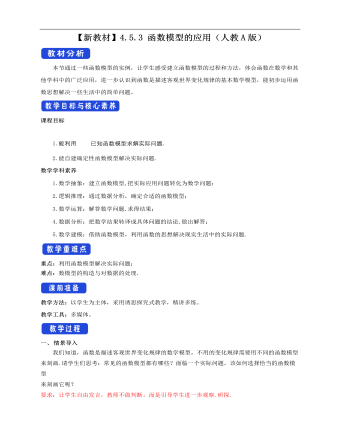
人教A版高中数学必修一函数模型的应用教学设计(2)
本节通过一些函数模型的实例,让学生感受建立函数模型的过程和方法,体会函数在数学和其他学科中的广泛应用,进一步认识到函数是描述客观世界变化规律的基本数学模型,能初步运用函数思想解决一些生活中的简单问题。课程目标1.能利用已知函数模型求解实际问题.2.能自建确定性函数模型解决实际问题.数学学科素养1.数学抽象:建立函数模型,把实际应用问题转化为数学问题;2.逻辑推理:通过数据分析,确定合适的函数模型;3.数学运算:解答数学问题,求得结果;4.数据分析:把数学结果转译成具体问题的结论,做出解答;5.数学建模:借助函数模型,利用函数的思想解决现实生活中的实际问题.重点:利用函数模型解决实际问题;难点:数模型的构造与对数据的处理.
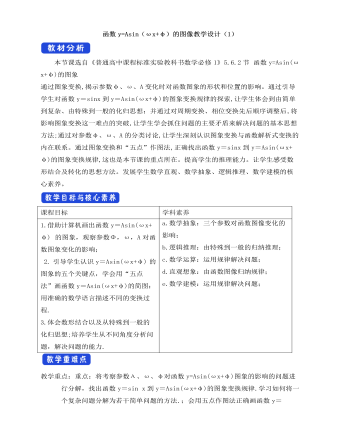
人教A版高中数学必修一函数y=Asin(ωχ+φ)教学设计(1)
本节课选自《普通高中课程标准实验教科书数学必修1》5.6.2节 函数y=Asin(ωx+φ)的图象通过图象变换,揭示参数φ、ω、A变化时对函数图象的形状和位置的影响。通过引导学生对函数y=sinx到y=Asin(ωx+φ)的图象变换规律的探索,让学生体会到由简单到复杂、由特殊到一般的化归思想;并通过对周期变换、相位变换先后顺序调整后,将影响图象变换这一难点的突破,让学生学会抓住问题的主要矛盾来解决问题的基本思想方法;通过对参数φ、ω、A的分类讨论,让学生深刻认识图象变换与函数解析式变换的内在联系。通过图象变换和“五点”作图法,正确找出函数y=sinx到y=Asin(ωx+φ)的图象变换规律,这也是本节课的重点所在。提高学生的推理能力。让学生感受数形结合及转化的思想方法。发展学生数学直观、数学抽象、逻辑推理、数学建模的核心素养。
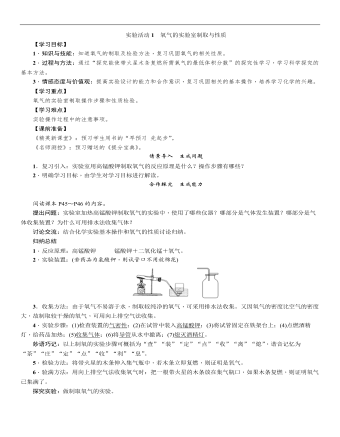
初中化学人教版九年级上册《实验活动1氧气的实验室制取与性质》教案
【学习目标】1.知识与技能:知道氧气的制取及检验方法,复习巩固氧气的相关性质。2.过程与方法:通过“探究能使带火星木条复燃所需氧气的最低体积分数”的探究性学习,学习科学探究的基本方法。3.情感态度与价值观:提高实验设计的能力和合作意识,复习巩固相关的基本操作,培养学习化学的兴趣。【学习重点】氧气的实验室制取操作步骤和性质检验。【学习难点】实验操作过程中的注意事项。【课前准备】《精英新课堂》:预习学生用书的“早预习先起步”。《名师测控》:预习赠送的《提分宝典》。情景导入 生成问题1.复习引入:实验室用高锰酸钾制取氧气的反应原理是什么?操作步骤有哪些?2.明确学习目标,由学生对学习目标进行解读。合作探究 生成能力阅读课本P45~P46的内容。提出问题:实验室加热高锰酸钾制取氧气的实验中,使用了哪些仪器?哪部分是气体发生装置?哪部分是气体收集装置?为什么可用排水法收集气体?讨论交流:结合化学实验基本操作和氧气的性质讨论归纳。
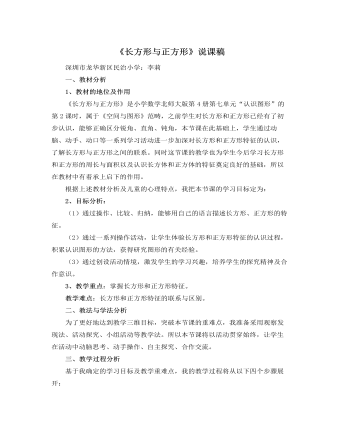
北师大版小学数学二年级下册《长方形与正方形》说课稿
(2)研究正方形:通过前面这个环节,学生已经掌握了研究长方形特征的方法,很自然地拿出一个正方形,通过看、数、量、折、小组讨论、展示交流等活动归纳出正方形的特征:正方形四条边都相等,四个角都是直角,这也是本节课的重点内容,但并不是难点,可由中下学生来完成,给他们以展示技能的机会。通过一系列的探究活动,学生的学习积极性已被调动,思维正处于活跃阶段,此时我把学生带到本节课的难点环节(3)想一想,长方形和正方形有什么相同点和不同点?对于学生的思考结果,老师并不急于回答,而是引导学生从长方形和正方形边和角的共同点去进行研究分析,让学生充分经历思考学习的过程,最后才巧妙地借助多媒体,直观地帮学生理解正方形是一个特殊的长方形,在这里多媒体化静为动,化抽象为直观,较好地帮学生突破了难点。至此,学生已经掌握了长方形、正方形的有关知识,此时,他们急于找到一块用武之地,以展示自我,体验成功,于是我把学生带入到“应用新知,理解提高”的环节。
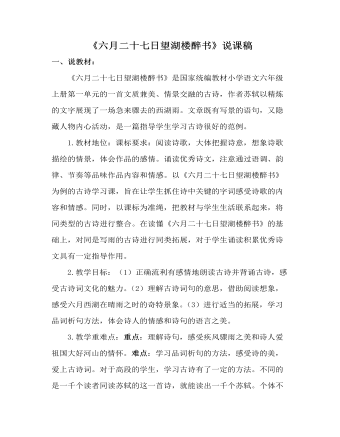
部编人教版六年级上册《古诗词三首:六月二十七日望湖楼醉书》说课稿
一、说教材:《六月二十七日望湖楼醉书》是国家统编教材小学语文六年级上册第一单元的一首文质兼美、情景交融的古诗,作者苏轼以精炼的文字展现了一场急来骤去的西湖雨。文章既有写景的语句,又隐藏人物内心活动,是一篇指导学生学习古诗很好的范例。1.教材地位:课标要求:阅读诗歌,大体把握诗意,想象诗歌描绘的情景,体会作品的感情。诵读优秀诗文,注意通过语调、韵律、节奏等品味作品内容和情感。以《六月二十七日望湖楼醉书》为例的古诗学习课,旨在让学生抓住诗中关键的字词感受诗歌的内容和情感。同时,以课标为准绳,把教材与学生生活联系起来,将同类型的古诗进行整合。在读懂《六月二十七日望湖楼醉书》的基础上,对同是写雨的古诗进行同类拓展,对于学生诵读积累优秀诗文具有一定指导作用。
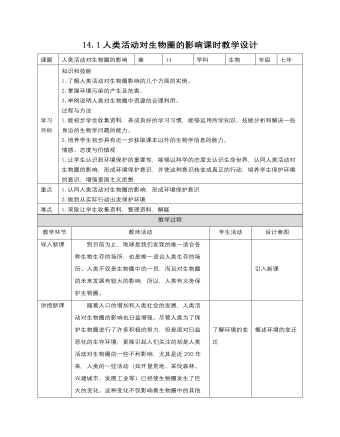
初中生物北师大版七年级下册《第14章第1节人类活动对生物圈的影响》教案
知识和技能 1.了解人类活动对生物圈影响的几个方面的实例。 2.掌握环境污染的产生及危害。 3.举例说明人类对生物圈中资源的合理利用。 过程与方法 1.能初步学会收集资料,养成良好的学习习惯,能够运用所学知识、技能分析和解决一些身边的生物学问题的能力。 2.培养学生初步具有近一步获取课本以外的生物学信息的能力。 情感、态度与价值观 1.让学生认识到环境保护的重要性,能够以科学的态度去认识生命世界,认同人类活动对生物圈的影响,形成环境保护意识,并使这种意识转变成真正的行动,培养学生保护环境的意识,增强爱国主义思想1.认同人类活动对生物圈的影响,形成环境保护意识 2.做到从实际行动出发保护环境1.采取让学生收集资料,整理资料,解疑
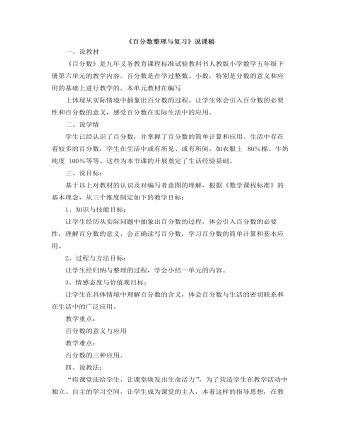
小学数学人教版六年级上册《百分数整理与复习》说课稿
一、说教材《百分数》是九年义务教育课程标准试验教科书人教版小学数学五年级下册第六单元的教学内容。百分数是在学过整数、小数,特别是分数的意义和应用的基础上进行教学的。本单元教材在编写上体现从实际情境中抽象出百分数的过程。让学生体会引入百分数的必要性和百分数的意义,感受百分数在实际生活中的应用。二、说学情学生已经认识了百分数,并掌握了百分数的简单计算和应用。生活中存在着较多的百分数,学生在生活中或有所见、或有所闻。如衣服上 80%棉、牛奶纯度 100%等等。这些为本节课的开展奠定了生活经验基础。
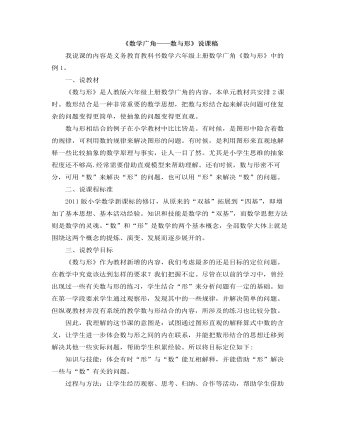
小学数学人教版六年级上册《数学广角——数与形》说课稿
五、说学情小学六年级的学生已具备初步的逻辑思维能力,但仍以形象思维为主,教材在小学中年级的数学教学中,已经逐渐借助推理与知识迁移来完成,并结合教材挖掘、创造条件开始渗透数形结合思想。进入中高年级后,学生逻辑思维能力已有一定发展,为了使学生更直观的理解知识,同时又满足学生逻辑思维能力的发展,因此本节教材在编排上体现了先“数”后“形”的顺序,把形象真正放在“支撑”地位,从而为培养学生的逻辑能力而服务。六、说教法学法为了在教学过程中充分体现学生的主体地位和教师的主导作用,本节采用教师引导和学生自主学习相结合的方法,培养学生积极探索和团结协作的精神,同时采用PPT课件直观形象的演示功能,强化理解,突破重点、难点并调动学生的学习积极性。1.将问题直接呈现在学生面前,引导学生对题目的内容进行理解,在明确了题目的要求之后,教师把时间还给学生,引导学生自主思考问题,通过具体形象教具的支撑帮助学生发展规律。2.利用小组合作学习,在合作交流中通过看一看,议一议,借助直观教具发现理解规律。3.利用微课对差生进行“补学”。在学生探究汇报之后,针对学习有困难的学生利用微课视频直观巩固知识。
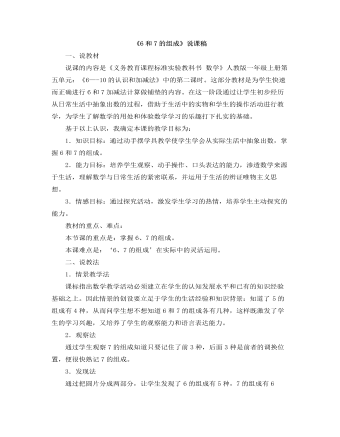
小学数学人教版一年级上册《6和7的组成》说课稿
一、说教材说课的内容是《义务教育课程标准实验教科书 数学》人教版一年级上册第五单元:《6—-10的认识和加减法》中的第二课时。这部分教材是为学生快速而正确进行6和7加减法计算做铺垫的内容。在这一阶段通过让学生初步经历从日常生活中抽象出数的过程,借助于生活中的实物和学生的操作活动进行教学,为学生了解数学的用处和体验数学学习的乐趣打下扎实的基础。基于以上认识,我确定本课的教学目标为:1.知识目标:通过动手摆学具教学使学生学会从实际生活中抽象出数,掌握6和7的组成。2.能力目标:培养学生观察、动手操作、口头表达的能力,渗透数学来源于生活,理解数学与日常生活的紧密联系,并运用于生活的辨证唯物主义思想。3.情感目标:通过探究活动,激发学生学习的热情,培养学生主动探究的能力。教材的重点、难点:本节课的重点是:掌握6、7的组成。本课难点是:‘6、7的组成’在实际中的灵活运用。
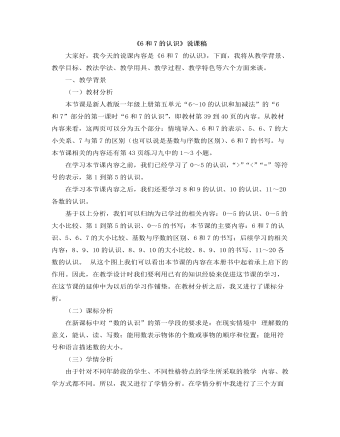
小学数学人教版一年级上册《6和7的认识》说课稿
大家好,我今天的说课内容是《6和7 的认识》,下面,我将从教学背景、教学目标、教法学法、教学用具、教学过程、教学特色等六个方面来谈。一、教学背景(一)教材分析本节课是新人教版一年级上册第五单元“6~10的认识和加减法”的“6和7”部分的第一课时“6和7的认识”,即教材第39到40页的内容。从教材内容来看,这两页可以分为五个部分:情境导入、6和7的表示、5、6、7的大小关系、7与第7的区别(也可以说是基数与序数的区别)、6和7的书写。与本节课相关的内容还有第43页练习九中的1~3小题。在学习本节课内容之前,我们已经学习了0~5的认识,“>”“<”“=”等符号的表示,第1到第5的认识。在学习本节课内容之后,我们还要学习8和9的认识、10的认识、11~20各数的认识。
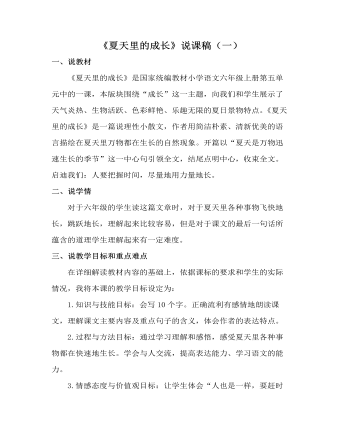
部编人教版六年级上册《夏天里的成长》说课稿(一)
二、说学情对于六年级的学生读这篇文章时,对于夏天里各种事物飞快地长,跳跃地长,理解起来比较容易,但是对于课文的最后一句话所蕴含的道理学生理解起来有一定难度。 三、说教学目标和重点难点 在详细解读教材内容的基础上,依据课标的要求和学生的实际情况,我将本课的教学目标设定为:1.知识与技能目标:会写10个字。正确流利有感情地朗读课文,理解课文主要内容及重点句子的含义,体会作者的表达特点。2.过程与方法目标:通过学习理解和感悟,感受夏天里各种事物都在快速地生长。学会与人交流,提高表达能力、学习语文的能力。3.情感态度与价值观目标:让学生体会“人也是一样,要赶时候,赶热天,尽量地用力地长。”的含义,从而懂得把握时间珍惜时间。
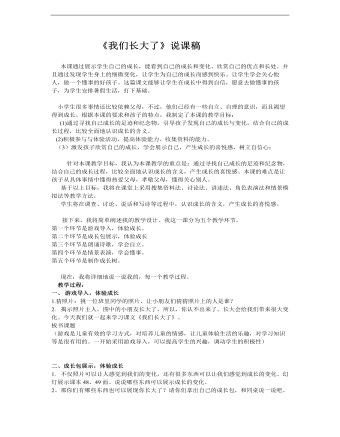
小学科学鄂教版四年级上册《我们长大了》说课稿
小学生很多事情还比较依赖父母,不过,他们已经有一些自立、自理的意识,而且渴望得到成长。根据本课的要求和孩子的特点,我制定了本课的教学目标: (1)通过寻找自己成长的足迹和纪念物,引导孩子发现自己的成长与变化,结合自己的成长过程,比较全面地认识成长的含义。 (2)积极参与与体验活动,提高体验能力、收集资料的能力。 (3)激发孩子欣赏自己的成长,学会展示自己,产生成长的喜悦感,树立自信心; 针对本课教学目标,我认为本课教学的重点是:通过寻找自己成长的足迹和纪念物,结合自己的成长过程,比较全面地认识成长的含义,产生成长的喜悦感。本课的难点是让孩子从具体事情中懂得热爱父母,孝敬父母,懂得关心别人。 基于以上目标,我将在课堂上采用搜集资料法、讨论法、讲述法、角色表演法和情景模拟法等教学方法。
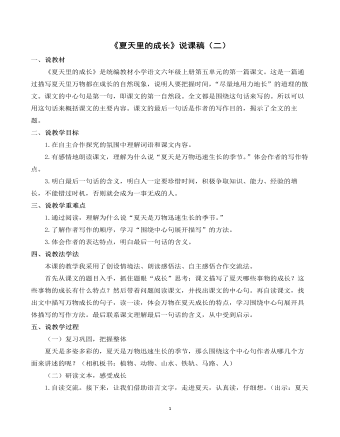
部编人教版六年级上册《夏天里的成长》说课稿(二)
3.明白最后一句话的含义,明白人一定要珍惜时间,积极争取知识、能力、经验的增长,不能错过时机,否则就会成为一事无成的人。 三、说教学重难点1.通过阅读,理解为什么说“夏天是万物迅速生长的季节。” 2.了解作者写作的顺序,学习“围绕中心句展开描写”的方法。 3.体会作者的表达特点,明白最后一句话的含义。四、说教法学法 本课的教学我采用了创设情境法、朗读感悟法、自主感悟合作交流法。首先从课文的题目入手,抓住题眼“成长”思考:课文描写了夏天哪些事物的成长?这些事物的成长有什么特点?然后带着问题阅读课文,并找出课文的中心句。再自读课文,找出文中描写万物成长的句子,读一读,体会万物在夏天成长的特点,学习围绕中心句展开具体描写的写作方法。最后联系课文理解最后一句话的含义,从中受到启示。